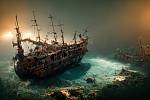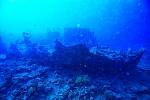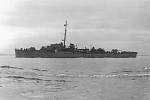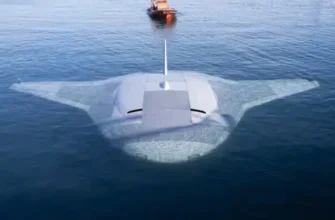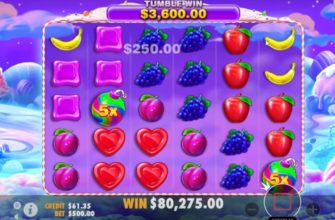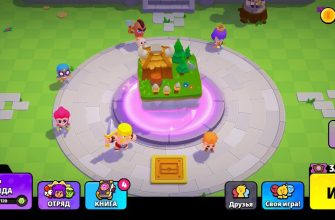A thousand dead prisoners. Scientists have found the Montevideo Maru, it is deeper than the Titanic
Researchers searching the South China Sea for the wreck of the Montevideo Maru, sunk 81 years ago, have now put an end to Australia’s biggest maritime disaster. They found it at a depth of four thousand meters, about one hundred kilometers northwest of the coast of the Philippines, so it lies deeper than the Titanic.
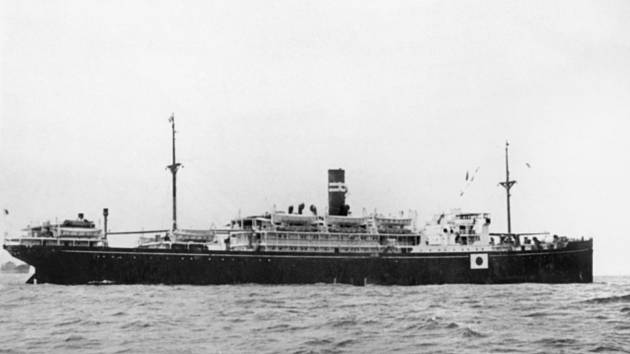
Click to enlarge
The merchant ship Montevideo Mara was used by the Japanese in 1942 to transport prisoners of war. Over a thousand people died when she sank
| Photo: Wikimedia Commons, author unknown, CC0
The end came very quickly. Early July 1942 US war submarine The USS Sturgeon was tracking an enemy Japanese vessel in the South China Sea. But the crew had no idea that more than a thousand prisoners of war were on board the Montevideo Maru on their way from Papua New Guinea to a Chinese island under Japanese control. On July 1, 1942, the submarine fired several torpedoes, the ship heeled sharply within six minutes and disappeared under the surface in another five minutes.
According to the Australian War Memorial, only seventeen members of the Japanese crew survived the sinking of the ship and the subsequent march through the Philippine jungle. At least 1,089 people from fourteen countries died, 979 of whom were Australian.
It took years for survivors to even learn that their loved ones had perished. And for the next few years, experts from the Australian Foundation for Maritime Archeology Silentworld, with the help of the Dutch deep-sea exploration company Furgo and the support of the Australian Department of Defense, searched for the place where the vessel lies.
“We were helped to put the whole story together by researchers from of the United States and Japan. There was a lot of information, but we were the first to try to assess it together and show where we think he could wreck lie down,” research technical director and submarine specialist Captain Roger Turner told Australia’s ABC news.
The researchers decided to use the knowledge gathered in the search, which they started on April 6 this year in the South China Sea, 110 kilometers northwest of the largest Philippine island of Luzon. And 81 years after the sinking of the Montevideo Maru, they finally succeeded. They located the wreck after twelve days, the BBC reported. It lies at a depth of four kilometers, deeper than Titanic.
A gruesome death in the deep
The work began by mapping the shape of the seabed. The research team’s self-propelled small submarine cruised at a constant speed above the sea floor. “The great thing for us was that the bottom there was amazingly boringly flat. This made it very easy to identify any find,” Turner explained to ABC News.
On the third launch, the submarine began to provide data that clearly showed that there was a wreck at the bottom, which in every way corresponded to the shape of the lost ship. But the researchers’ work did not end there. “We are still continuing with a more detailed survey of the field wreckage under the ship. We hope to gain more knowledge that will allow us to better understand what exactly happened then and how,” informed Turner.
During their work, however, the researchers were aware that they were primarily uncovering a place huge human tragedy. Therefore, they do not plan to penetrate the vessel or retrieve anything from it. “It’s a war grave now and we have to treat it as such,” Turner told the BBC.
He confirmed that locating the wreck was a moving experience for the team members. “When you see the pictures of the ship, you see the closed entrances to the holds where the captives were kept during the voyage, it’s an emotional moment,” he noted.
John Mullen, director of the search foundation Silentworld, also spoke to ABC. “We are looking at the grave of more than a thousand people. This is twice the number of Australian casualties in the entire Vietnam War. That’s why finding the wreck is so important to families and descendants. We had two of those who lost family members on board during the research,” Mullen said, adding that the confirmation of the wreckage was therefore accompanied by shouts of excitement and tears.
I can’t leave…
One of the survivors mentioned was Andrea Williams, who lost her grandfather and great-uncle. Both were civilians interned by the Japanese after the occupation of Papua New Guinea.
“For all Australians connected to this tragedy, the discovery of the wreckage is an extraordinarily significant day. For me and for so many generations connected to all the victims of the Montevideo Maru, this is a very important story and I have never understood why it does not play a bigger role in Australian memories of the second world war,” said Williams, a founding member of a society representing survivors and descendants of victims.
Cathy Parry-McLennan is also among those who keep the memory of an ancestor who died on the ship alive. Her grandfather, Arthur Parry, was a ship’s radiologist. She recalled to ABC News that her grandmother and father, who was just 13 when Dr. Petry disappeared, waited for years to find out what happened.
“They knew he was in New Guinea, they got letters from him… Then it was said that maybe he was beheaded in captivity, or that he was still hiding somewhere. And finally the official telegram came. It’s so nice to finally hear that they’ve been found. Dad always remembered Grandpa as a loving person and a bit of a joker too,” said granddaughter McLennan.
The family keeps the yellowed newspaper clipping. A 1958 article describes the arrival of the Japanese in New Guinea and the occupation of Rabaul. Perry worked as a doctor there, but after the outbreak of war, he was initially denied permission to return to Australia and later refused evacuation himself. “I can’t leave, there are 200 boys in the hospital and I have to do what I can to take care of them,” quotes an old article by Arthur Perry.

